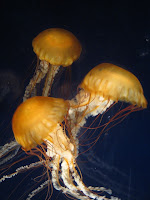This past week my husband, one of my sisters, and I went to Chattanooga, Tennessee for a few days. It had been a destination of interest for some time because of its close proximity (only four hours). We'd each been to the city once before but hadn't had time to take in its burgeoning local food and alternative energy movement, its mountainous surroundings, nor its award-winning aquarium. We were not disappointed. In fact, I was pleasantly surprised.
Before our official arrival in Chattanooga we took a minor detour over the state border to Alabama in search of Russell Cave, a National Historic Monument. We were so close to the site that my husband the geologist was set on showing off where he'd done some college research. I was fascinated to learn that this particular place has one of the most complete archaeological records in North America. Before European contact this cave had been inhabited regularly by Native Americans for thousands of years. Today only the mouth of the cave is open for public viewing. By preserving, studying, and making public its artifacts, folks like me in the twentieth century can begin to catch a glimpse of what the lifestyle of these ancient tribes was like. Russell Cave was a short stop on our trek, but well worth the meander to find it.
Chattanooga proper has had a major renaissance of its downtown in the past few decades. The streets are clean and the buildings are refurbished. The atmosphere is made lively by a myriad of restaurants, shops, and businesses; but the city is small, southern, and charming. The arts community is proudly present in the galleries, Hunter Museum, symphony hall, and creative spaces woven into the city's infrastructure. Care has been taken to add thoughtful details in unlikely places -- details that visitors like us would enjoy discovering: small leaf-prints in concrete sidewalks; pathways and bridges with aquatic themes that mimic the nearby aquarium and surrounding Tennessee River; and brick sculptures of trains, wagons, and Model Ts dotted along the streets welcoming passersby to pose for a picture or read of the item's significance in Chattanooga's past and present. We didn't necessarily come to the region for a history lesson, but we couldn't leave without the imprint that Chattanooga was a thoroughfare in the Railway Era, a pinnacle spot during the Civil War, and a modern example of a city dedicated to sustainability, arts, and education. Their free electric shuttles take visitors and commuters across town saving parking congestion, unneeded emissions, and excess fuel use. Many of the restaurants boast local and seasonal items. We found ourselves finishing one meal and contemplating the next in hopes of taking in as many delicious options as we could!
 |
| Point Park National Military Monument at Lookout Mountain |
I never make it long past the new year before I'm digging out a map and checking the calendar with my husband. Our commitment to live frugally year-round goes hand-in-hand with our desire to have a budget for travel to see the world both near and sometimes far. Most times it's the intrigue of something new to see or experience that points us in a direction for our winter getaway. Whether I intend to or not I often learn something about that place, its people, its history, and its culture. Undoubtedly I also connect some dots with what I already know about how the world works, the passage of time, and the transfer of technology and information. Connecting the dots in life is one of the blessings and responsibilities of being human -- understanding the past, grasping the present, and positively influencing the future. In my estimation, getting out in the world for any length of time, no matter how small my budget, is a worthwhile effort to continue my education. Besides, there are a lot of other perks to being a grown-up on your own field trip...eating ice cream two days in a row, buying what you want in the gift shop, and not needing a signed permission slip to go!




No comments:
Post a Comment